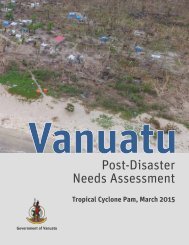Fiji
yqgk302EGjo
yqgk302EGjo
Create successful ePaper yourself
Turn your PDF publications into a flip-book with our unique Google optimized e-Paper software.
FIJI Post-Disaster Needs Assessment<br />
<strong>Fiji</strong>’s Eastern Division was the first to be struck, with Koro, Ovalau and Taveuni Islands sustaining severe damage. The<br />
cyclone swept across <strong>Fiji</strong>’s islands, reaching its peak strength shortly before making landfall on the country’s largest island,<br />
Viti Levu, which has a population of 600,000. Maximum average wind speeds reached 233km/hour and wind gusts peaked<br />
at around 306km/hour, making Winston one of the most powerful cyclones ever recorded in the Southern Hemisphere. 13<br />
Many islands were struck by storm surges, including Koro Island and the southern coast of <strong>Fiji</strong>’s second-largest island,<br />
Vanua Levu, which occurred almost 200m inland.<br />
Legend<br />
Winston Position<br />
Winston Track<br />
Hurricane<br />
Storm<br />
Gale<br />
Figure 7: TC Winston Track across <strong>Fiji</strong> (East to West)<br />
Source: Preliminary <strong>Fiji</strong> Met briefing.<br />
Following TC Winston’s passage from <strong>Fiji</strong>, widespread damage and destruction was reported, and approximately 540,400<br />
people were impacted by the cyclone or approximately 62 percent of the population. 14 The storm brought down the power<br />
and communications systems linking the islands, with approximately 80 percent of the nation’s population losing power,<br />
including the entire island of Vanua Levu. This hampered initial efforts to obtain a comprehensive understanding of the full<br />
scale of the disaster’s impacts.<br />
Forty-four fatalities were subsequently confirmed, entire communities were destroyed and approximately 40,000 people<br />
required immediate assistance following the cyclone. 15 30,369 houses, 495 schools, and 88 health clinics and medical<br />
facilities were damaged or destroyed, and crops were destroyed on a large scale, compromising the livelihoods of almost<br />
60 percent of <strong>Fiji</strong>’s population.<br />
1.4 Response from the Government and<br />
Development Partners<br />
A state of natural disaster was declared by the Government of <strong>Fiji</strong> for the Central, Western, Eastern and Northern Divisions<br />
on February 20, 2016. Following the event, the government declared a state of emergency, and has been leading response<br />
efforts, which are being coordinated by nine national humanitarian clusters 16 led by government ministries. Humanitarian<br />
partners, international and national non-governmental organizations (NGOs), foreign governments, donors and civil<br />
society are also supporting the government-led response. The government has implemented a range of social protection<br />
programmes to support households, including the provision of additional funds to households via the Poverty Benefit<br />
Scheme, the Food Voucher Programme and the Help for Homes initiative, which will provide affected households with<br />
vouchers for housing rehabilitation and reconstruction.<br />
13<br />
These preliminary figures are from the <strong>Fiji</strong> Meteorological Service.<br />
14<br />
Population and Labour Force Estimates 2014.<br />
15<br />
<strong>Fiji</strong>: Severe Tropical Cyclone Winston Situation Report No. 11 (as of 3 March 2016) (PDF) (Situation Report). ReliefWeb. United Nations<br />
Office for the Coordination of Humanitarian Affairs. Retrieved 3 March 2016.<br />
16<br />
The national humanitarian clusters are: Communications; Education; Food Security and Livelihoods; Health and Nutrition; Logistics;<br />
Public Works and Utilities; Shelter; Safety and Protection; and WASH.<br />
20 Tropical Cyclone Winston, February 20, 2016



